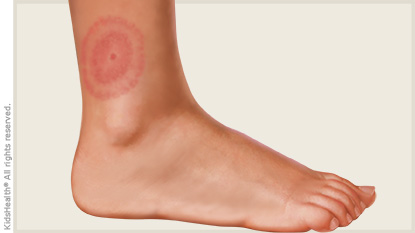How Do I Watch for Lyme Disease After Removing a Tick?
I found a tick on my daughter's arm last night. I pulled it off, but I have no idea how long it had been there, as she plays outside every day. What should I do? How do I tell if the tick gave her Lyme disease?
– Mara
Lyme disease is caused by the bacterium Borrelia burgdorferi and transmitted primarily by deer ticks. In the United States, Lyme disease is most common in the Northeast, Northwest, and parts of the upper Midwest. So where you live (or travel) and what type of tick you find will help determine if your child is at risk of developing Lyme disease.
Not all deer ticks are infected with the bacteria that cause Lyme disease. And a tick that is infected has to be attached to a person's skin for at least 24-48 hours before it can transmit that bacteria. Since you don't know how long the tick was attached, watch for signs that your daughter might be developing the illness.
Many kids who have Lyme disease develop a red rash at the site of the tick bite, which sometimes has a characteristic "bull's-eye" appearance. In the week or two after the tick bite, look for an expanding ring of solid redness or a red bump surrounded by clear skin that is ringed by an expanding red rash. The rash may be accompanied by flu-like symptoms like fever, headache, fatigue, and muscle and joint aches.
If she has a bull's-eye rash or other symptoms that can happen in Lyme disease, call your doctor right away. Early diagnosis and treatment of Lyme disease can prevent serious illness and long-term complications. When diagnosed quickly and given a course of antibiotics, kids with Lyme disease almost always have a good outcome.
Parents can help prevent kids from being exposed to ticks by making sure they wear protective clothing and apply insect repellant containing DEET, especially when playing in grassy or wooded areas where ticks live. Check kids for ticks every day.
Note: All information is for educational purposes only. For specific medical advice, diagnoses, and treatment, consult your doctor.
© 1995-2024 KidsHealth ® All rights reserved. Images provided by iStock, Getty Images, Corbis, Veer, Science Photo Library, Science Source Images, Shutterstock, and Clipart.com

